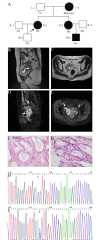Genetic variation at a splicing branch point in intron 7 of STK11: a rare variant decreasing its expression in a Chinese family with Peutz-Jeghers syndrome
- PMID: 39080663
- PMCID: PMC11290102
- DOI: 10.1186/s12957-024-03475-6
Genetic variation at a splicing branch point in intron 7 of STK11: a rare variant decreasing its expression in a Chinese family with Peutz-Jeghers syndrome
Abstract
Background: Peutz-Jeghers syndrome (PJS), a rare dominantly inherited disease, is primarily characterized by hamartomatous polyps and melanotic macules as well as by an increased risk of cancer. The current study aimed to identify the pathogenic gene and pathogenic mechanism of a proband with PJS, thereby offering precise prevention and treatment strategies for PJS.
Methods: A detailed clinical examination was performed of the proband diagnosed with PJS and her family members. In addition, peripheral venous blood was collected from the family members to extract genomic DNA. The pathogenic genes of the proband were identified using whole-exome sequencing, and the candidate pathogenic variants were verified via Sanger sequencing. Meanwhile, co-segregation tests were performed among six family members. Finally, reverse transcription-polymerase chain reaction (RT-PCR) was performed to assess transcript variants in the peripheral blood cells of patients and non-related healthy controls.
Results: Genetic testing revealed a rare splicing variant c.921-1G > C in STK11 in the proband and in her sister and nephew, and the variant co-segregated among the affected family members and nonrelated healthy controls. The proband phenotypically presented with a rare gastric-type adenocarcinoma of the cervix. RT-PCR revealed that the STK11 c.921-1G > C variant could produce two transcripts. Of note, 40 base pairs were deleted in the aberrant transcript between exons 3 and 4, resulting in a frameshift variant and premature termination of the amino acid in exon 6 and ultimately leading to the loss of its functional domain in the STK11 protein. Finally, RT-PCR showed that compared with healthy controls, STK11 mRNA expression level was < 50% in patients.
Conclusion: The present study results indicated that the rare splicing variant c.921-1G > C in intron 7 of STK11 may be a pathogenic variant in patients with PJS. However, this variant (in intron 7) may not produce abnormal transcripts (deletion of 40 base pairs between exons 3 and 4), and PJS may be attributed to the decrease in STK11 expression. Therefore, this study emphasized the importance of genetic counseling, pre-symptomatic monitoring, and early complication management in PJS.
Keywords: STK11; Gastric-type adenocarcinoma of the cervix; Genetic testing; Peutz–Jeghers syndrome; Variant.
© 2024. The Author(s).
Conflict of interest statement
The authors declare that there is no duality of interest associated with this manuscript.
The authors declare no competing interests.
Figures


Similar articles
-
A novel pathogenic splice site variation in STK11 gene results in Peutz-Jeghers syndrome.Mol Genet Genomic Med. 2021 Aug;9(8):e1729. doi: 10.1002/mgg3.1729. Epub 2021 Jun 3. Mol Genet Genomic Med. 2021. PMID: 34080793 Free PMC article.
-
A novel missense mutation of the STK11 gene in a Chinese family with Peutz-Jeghers syndrome.BMC Gastroenterol. 2022 Dec 22;22(1):536. doi: 10.1186/s12876-022-02617-y. BMC Gastroenterol. 2022. PMID: 36550395 Free PMC article.
-
Novel germline STK11 variants and breast cancer phenotype identified in an Indian cohort of Peutz-Jeghers syndrome.Hum Mol Genet. 2019 Jun 1;28(11):1885-1893. doi: 10.1093/hmg/ddz027. Hum Mol Genet. 2019. PMID: 30689838
-
Peutz-Jeghers Syndrome.2001 Feb 23 [updated 2021 Sep 2]. In: Adam MP, Feldman J, Mirzaa GM, Pagon RA, Wallace SE, Amemiya A, editors. GeneReviews® [Internet]. Seattle (WA): University of Washington, Seattle; 1993–2025. 2001 Feb 23 [updated 2021 Sep 2]. In: Adam MP, Feldman J, Mirzaa GM, Pagon RA, Wallace SE, Amemiya A, editors. GeneReviews® [Internet]. Seattle (WA): University of Washington, Seattle; 1993–2025. PMID: 20301443 Free Books & Documents. Review.
-
Can tandem alternative splicing and evasion of premature termination codon surveillance contribute to attenuated Peutz-Jeghers syndrome?Am J Med Genet A. 2022 Oct;188(10):3089-3095. doi: 10.1002/ajmg.a.62942. Epub 2022 Aug 10. Am J Med Genet A. 2022. PMID: 35946377 Review.
Cited by
-
The Importance of Genetic Screening on the Syndromes of Colorectal Cancer and Gastric Cancer: A 2024 Update.Biomedicines. 2024 Nov 21;12(12):2655. doi: 10.3390/biomedicines12122655. Biomedicines. 2024. PMID: 39767561 Free PMC article. Review.
-
Evaluating the detection rate and pathological features of polyps in patients with upper gastrointestinal endoscopy.World J Gastrointest Endosc. 2025 May 16;17(5):105471. doi: 10.4253/wjge.v17.i5.105471. World J Gastrointest Endosc. 2025. PMID: 40438721 Free PMC article.
References
MeSH terms
Substances
Grants and funding
- WX21Q08/Grants from the Health and Family Planning Commission of Wuhan City
- WX18M02/Grants from the Health and Family Planning Commission of Wuhan City
- JZ2022011/Guangdong Yiyang Healthcare Charity Foundation
- No. 2022BGE272/the Central Guiding Local Science and Technology Development Special Project
LinkOut - more resources
Full Text Sources
Molecular Biology Databases

